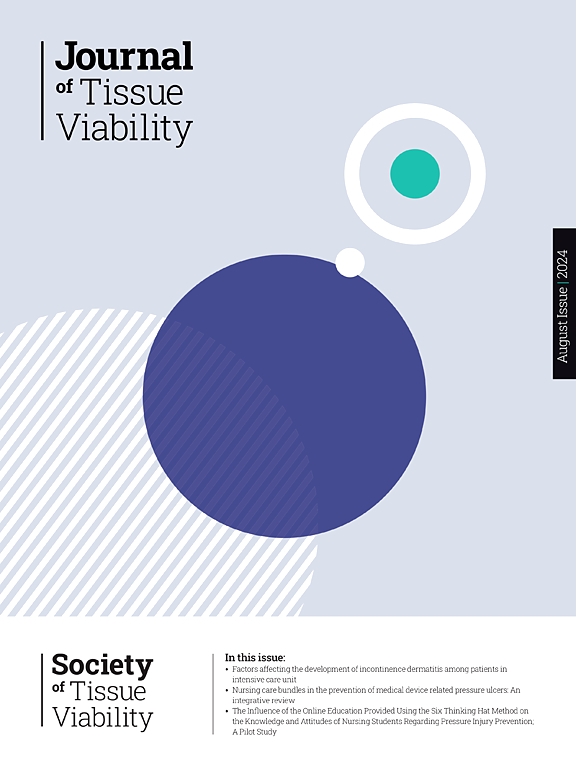Factors influencing Patient engagement in preventing pressure injuries: A cross-sectional study in Orthopedic inpatients
IF 2.4
3区 医学
Q2 DERMATOLOGY
引用次数: 0
Abstract
Aim
This study aimed to explore the level of patients’ engagement behaviours in preventing pressure injury (PI) and the influencing factors related to it.
Background
The importance of “Patient and Family Engagement” was recognized as one of the key components in the outline of the 2023 Global Patient Safety Report. PIs were common and concerning patient safety events in Orthopaedics department. Active patient participation behaviour can effectively prevent the occurrence of PIs.
Method
This was a cross-sectional study involving 366 participants from Orthopaedics in China who has high level of risk in PI. The behavioural level of patients' participation in PI prevention was measured using a research tool designed by the research team. Based on the theory of planned behaviour, the possible influencing factors were determined, and the corresponding research tools were selected for evaluation. Univariate analysis, correlation analysis and multiple stepwise regression were used to determine the influencing factors of patients’ participation behaviour with SPSS 25.0.
Results
The total score of orthopaedic inpatients participating in PI preventive behaviour was 89.45 ± 10.64, with a scoring rate of 85.19 % (actual score/maximum possible score × 100 %), indicating relatively high adherence. Multiple regression analysis revealed that social support showed the strongest positive association (β = 0.291, P < 0.001), suggesting enhanced support networks facilitate engagement. Participation attitude (β = 0.211, P < 0.001) and health literacy (β = 0.233, P < 0.001) were key cognitive facilitators. Unexpectedly, cohabitation with children exhibited negative correlation (β = −0.141, P = 0.001), potentially indicating caregiving role transfer. Inter-hospital transfers (β = −0.120, P = 0.004) and medium-length stays (4–7 days, β = −0.089, P = 0.010) were inversely related, possibly reflecting care continuity challenges. Social Security recipients demonstrated greater participation (β = 0.108, P = 0.009), highlighting socioeconomic influences.
Conclusion
Our findings may guide clinical healthcare providers to develop more targeted interventions to promote patient engagement in self-care, including encouraging family members to involve in PI prevention with patients, improving patients’ attitude of participation, and supporting more health education of PI prevention. It was a potential suggestion for patient participation behaviour in medical services to prevent other types of adverse events as well.
影响患者参与预防压力性损伤的因素:骨科住院患者的横断面研究
目的探讨患者参与行为在预防压力性损伤(PI)中的水平及其影响因素。《2023年全球患者安全报告》大纲认为,“患者和家庭参与”的重要性是关键组成部分之一。PIs是骨科常见且涉及患者安全的事件。积极的患者参与行为可以有效预防pi的发生。方法本研究是一项横断面研究,涉及366名来自中国骨科的PI高危人群。使用研究小组设计的研究工具测量患者参与PI预防的行为水平。基于计划行为理论,确定可能的影响因素,并选择相应的研究工具进行评价。采用SPSS 25.0软件对患者参与行为的影响因素进行单因素分析、相关分析和多元逐步回归分析。结果骨科住院患者参与PI预防行为的总得分为89.45±10.64,评分率为85.19%(实际得分/最大可能得分× 100%),依从性较高。多元回归分析显示,社会支持表现出最强的正相关(β = 0.291, P <;0.001),这表明增强的支持网络促进了参与。参与态度(β = 0.211, P <;0.001)和健康素养(β = 0.233, P <;0.001)是关键的认知促进因素。出乎意料的是,与孩子的同居表现出负相关(β = - 0.141, P = 0.001),可能表明照顾角色转移。医院间转院(β = - 0.120, P = 0.004)和中等住院天数(4-7天,β = - 0.089, P = 0.010)呈负相关,可能反映了护理连续性的挑战。社会保障接受者表现出更高的参与度(β = 0.108, P = 0.009),突出了社会经济的影响。结论本研究结果可指导临床医疗服务提供者制定更有针对性的干预措施,包括鼓励家庭成员与患者一起参与PI预防,改善患者的参与态度,并支持更多的PI预防健康教育,以促进患者参与自我护理。这是一个潜在的建议,病人参与医疗服务的行为,以防止其他类型的不良事件。
本文章由计算机程序翻译,如有差异,请以英文原文为准。
求助全文
约1分钟内获得全文
求助全文
来源期刊

Journal of tissue viability
DERMATOLOGY-NURSING
CiteScore
3.80
自引率
16.00%
发文量
110
审稿时长
>12 weeks
期刊介绍:
The Journal of Tissue Viability is the official publication of the Tissue Viability Society and is a quarterly journal concerned with all aspects of the occurrence and treatment of wounds, ulcers and pressure sores including patient care, pain, nutrition, wound healing, research, prevention, mobility, social problems and management.
The Journal particularly encourages papers covering skin and skin wounds but will consider articles that discuss injury in any tissue. Articles that stress the multi-professional nature of tissue viability are especially welcome. We seek to encourage new authors as well as well-established contributors to the field - one aim of the journal is to enable all participants in tissue viability to share information with colleagues.
 求助内容:
求助内容: 应助结果提醒方式:
应助结果提醒方式:


